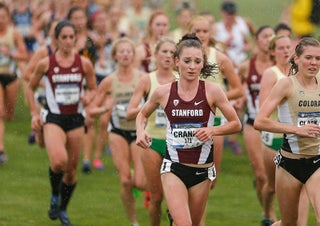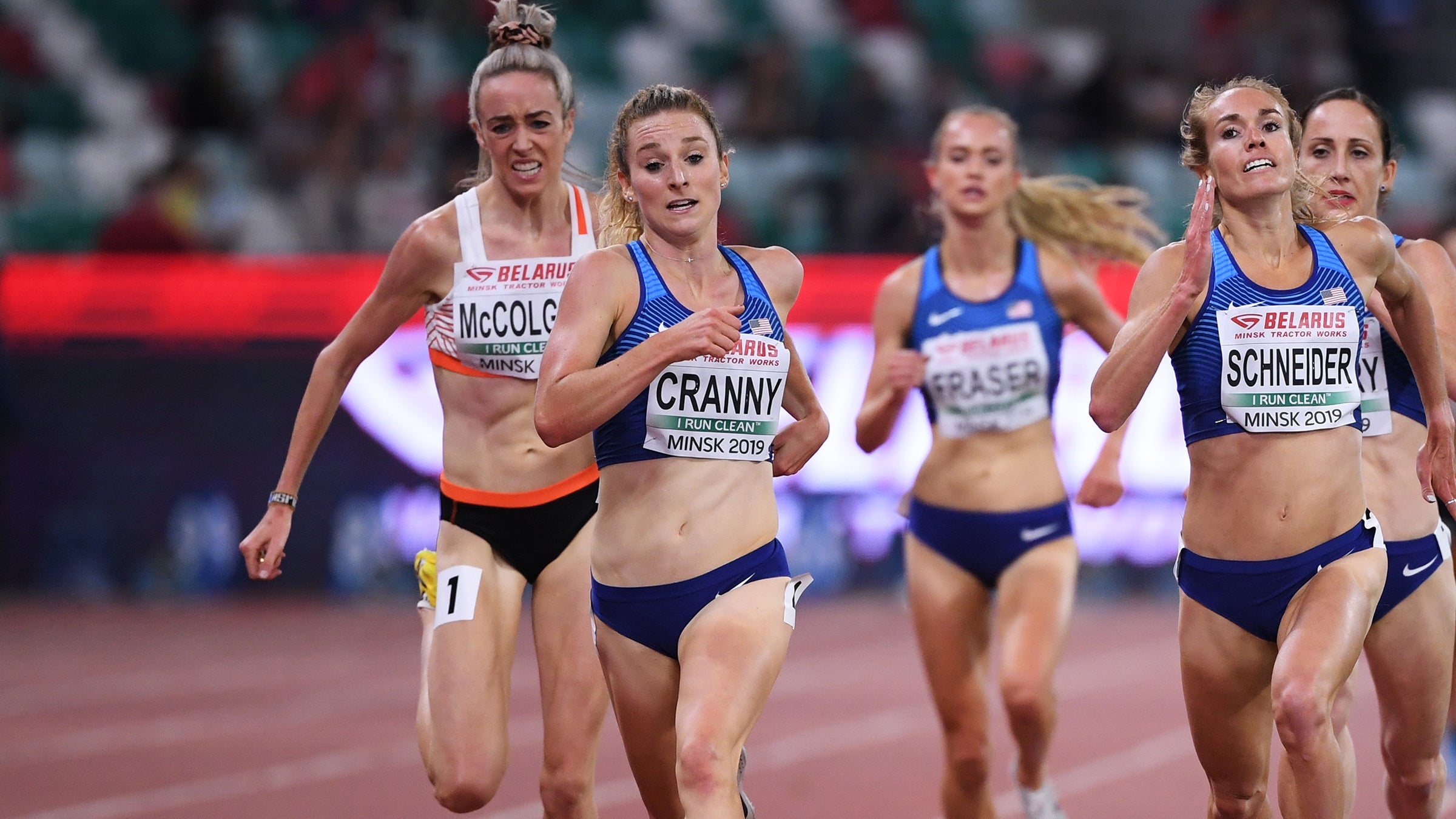It’s no surprise that Elise Cranny enjoys the mountains during altitude camp. She grew up collecting Colorado state cross-country titles for Niwot High School, so despite the grueling months of training with the Bowerman Track Club, she still feels refreshed.
“When we are up at altitude, the bar is being continually raised,” she says. “It’s really challenged me to be able to do workouts that maybe I didn’t think I could do.”
Cranny joined the BTC in 2019 and was one of the younger athletes contending at the Trials after an unexpected bonus year of settling into pro athlete life. In that time, she improved at every distance she raced, including her debut at 10,000 meters (30:47.42), as well as bests at 1500 meters (4:02.62) and 5,000 meters (14:48.02).
She arrived in Eugene, Oregon, for the Trials with declared entry in all three events, and ultimately scratched the 1500 meters. Cranny won a strategic 5,000 meters in 15:27.81, on a hot day to earn her place at her first Olympics. She placed fourth in the 10,000 meters, one place shy of making that team, too.
In the opening 5,000m round in Tokyo, she stayed in the back of the lead pack that was running relatively slowly, then moved confidently into the top 5 when the pace picked up in the last two laps, holding on to fourth in the final kick to ensure an automatic qualifying berth for the final.
Her coach Jerry Schumacher told her early on in her career that she needed to “run a pretty good 10K to run a fast 5K.” Mission accomplished.
“It was just cool to see that in a year and a half, trusting in Jerry and my teammates, just putting in that consistent work and getting that strength, that it really translated to the shorter races, too,” Cranny says.
In her short time learning the ropes as a pro runner, Cranny says one of the cornerstones of her progress has been learning that doing more isn’t always better.
“That’s been huge as the workout intensity has increased, going from the collegiate scene to the professional scene, just not underestimating sleep and naps and nutrition and all those little things that are really so important to keeping up consistency,” she says. “I think having a whole other year of training under Jerry was really huge, physically and mentally.”
Cranny has also reaped rewards from implementing strength training that’s more specific to her needs, addressing her weaknesses and imbalances. It’s improved her ability to withstand the higher load of training without getting injured, she says, and also made her stride and form more efficient.
Perhaps most importantly, Cranny says, she’s worked on her mental game, increasing her confidence and bringing more courage to her workouts.
“When I was a younger athlete, I was a little bit too focused on getting the confidence from external sources or from a couple of good workouts,” she says. “You can’t be constantly shaken by a bad workout…and you also have to keep it fun, joyful, and exciting. Focus on what you’re doing well and what’s allowing you to grow and take steps forward.”

Age: 25
Hometown: Portland, Oregon
Event/PRs: 1500 meters (4:02.62), 5,000 meters (14:48.02), 10,000 meters (30:47.42)
Training tip: Like most of us, Cranny has had injury setbacks and other unplanned hiatuses from training and racing. Consistency is king in progression, so she’s learned to let patience lead her decisions, which has resulted in big breakthroughs like her 10,000-meter debut in February.
“This past year we’ve had to take a step back from racing a ton and really focus on honing mental skill that I needed to work on just in practice,” Cranny says. “I needed to try different racing strategies and work on my confidence. Looking back, I feel grateful for that time to try new things and get a whole other year of consistency as a younger athlete.”
Favorite workout: Despite the step up to longer race distances, Cranny still craves a good speed session — shorter reps with longer rest are her jam, especially when she gets to do them with teammates like Gabriela DeBues-Stafford and Sinclaire Johnson.
“You’re not getting a ton of volume, but it’s a chance to run really fast with the speedsters on the team,” Cranny says. “That’s always one of my favorites, to be pushed by them and just see how fast I can go.”
The worst part of race day: When Cranny gets to the track and it’s time to warm up for the race.
“You’ve been waiting all day and you’re trying not to read too much into how you feel,” she says. “You’re excited to race and you kind of just want to be warmed up and ready to go — you’re close, but you’re not quite to the race.”
The best part of race day: Learning how to harness nervous energy into something positive.
“It’s something I’ve had to work on, using the nerves as excitement to step on the line,” Cranny says. “I think that’s what’s so cool about our sport is you get on the line and you have as good a chance as anyone to finish in any place. It doesn’t matter what your PRs are if you’re ready to go on that given day. That’s something that really excites me, just standing on the line, putting myself in the best position I can, and knowing anything can happen.”
Trials success (aside from the obvious goal of making Team USA): If Cranny can stay out of her own way and let herself perform to what she knows she’s capable of, she’ll find satisfaction in the results.
“I want to run with confidence and compete,” she says. “We talk about this a lot as a team — at the end of the day, that’s all we want for our teammates. I would view it as successful if I’m not afraid to put myself in it, race with confidence, and be the best version of myself on that day.”
Last words to herself on the starting line: “Sisu,” is a Finnish word for strength and perseverance and it’s one Cranny says to herself often. She also writes a Bible verse on her wrist.
“I like to repeat on the line, ‘I can do anything through Christ who gives me strength,’” Cranny says. “So I really kind of cultivate that strength and think about that on the start line.”
Sage advice: Jason Hartmann, Cranny’s coach in high school, and Chris Miltenberg, her coach at Stanford University, gave similar wisdom.
“They taught me I have to cultivate confidence from myself and not find it from a coach, a teammate, or a workout,” Cranny says. “And they also similarly taught me to celebrate the steps I’m taking forward. We always want more, but sometimes along the way you need to celebrate the progress you’re taking even if you’re still not where you want to be.”
Pandemic pastimes: During altitude training camp in Park City, Utah, Cranny, who also took up the ukulele last year, read a lot of books. She’ll read just about anything her teammate Marielle Hall tells her to, she says. Her recent favorite is Small, Great Things by Jodi Picoult, about “a gripping moral dilemma that will lead readers to question everything they know about privilege, power, and race.”
“I’ve done probably the most reading I have in a while,” Cranny says.
From Women’s Running


